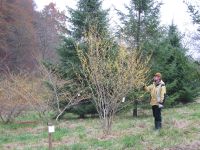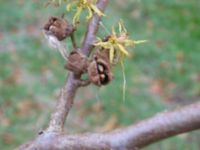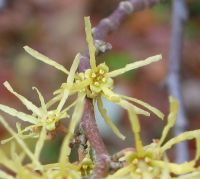Witch hazel - Hamamelis virginiana
English name:
Witch hazel
Scientific name:
Hamamelis virginiana
Family:
Hamamelidaceae (Witch hazel family)
Height:
Up to 6 M in Hørsholm
Flowering:
September to November
Range:
Eastern North America, from Tennessee and Carolinas to Nova Scotia
 |
|
 |
 |
The Hamamelis virginiana in the picture is from seed collected in the wild in Ontario Canada that was donated by Guelph Arboretum. It can be found in the North America collection near the far back corner of the Arboretum, in square 2701 position 2501.
Plant description:
A hard, autumn frost (under -5 oC) often ruins autumn colours of many plants in the Hørsholm Arboretum. The leaves die before they begin to develop colour. We had one such frost just a few weeks ago. But in spite of the effect of this frost on many leaves, the flowers of the impressively frost tolerant Hamamelis virginiana survived untouched. Two of our examples are now quite showy with their striking display of flowers.
The genus Hamamelis contains 5 or 6 species. The name was given by Linnaeus in 1846. It was derived from Hama together and mela fruit, probably referring to the fact that the fruit lasts 12 months in Hamamelis virginiana before bursting open and releasing their seed. Thus the mature fruit and flowers occur together. This genus has two natural ranges, one in Eastern Asia and one in North America. Plants of this genus are mainly used as ornamentals but they are also used for medicines. We have 4 species of Hamamelis and many hybrids, in our collection in Hørsholm and 13 examples of Hamamelis virginiana. Our oldest was planted in 1845. It is not the best looking plant at the moment, but has new suckers growing from the base and perhaps can survive as a clone for some time yet. This specimen can be found in our satellite collection in the Forest Botanic Garden in Charlottenlund.
Hamamelis virginiana has been in cultivation in Europe since the first half of the 1700s and in Denmark for at least 200 years. However, it is still not common as a garden plant, perhaps because propagation is not easy. Furthermore, most individuals tend to hide their flowers behind the yellowing leaves. Nevertheless, varieties exist which typically flower after leaf fall we have two such clones in our collection. Hamamelis virginiana rarely has disease or insect problems.
This species is the last to be in full flower in our collection and thus marks the end of the blooming season for us. Like other species in this genus the flowers have a nice sent. Not surprisingly perhaps, only less than 1 % of the flowers produce seed in this late flowering species. Nevertheless, there appear to be many species of insects that are potential pollinators even so late in the year. The most common pollinators are flies and small bees. Active flies can be seen on our plants now and then. Natural regeneration in this species is mostly vegetative as less successful seed production is so low. After pollination, the fruits become dormant over winter and start developing the next spring.
These deciduous shrubs (or small trees) are about as wide as they are high but as under-story plants they tend to be wider that high. Leaves are alternate, broadly ovate, unevenly round-toothed and unequal at the base. The veins beneath and the petiole are downy. The leaves yellow in the fall. The 4, golden-yellow, strap-shaped petals are typical for this genus and the autumn flowering is unique among the different species of this genus. The fruit is a woody capsule that bursts (reportedly with a distinct sound) launching the two shinny-black seed with beige tips.
References:
Anderson, G.A. & Hill, J.D. 2002. Many to flower, few to fruit: the reproductive biology of Hamamelis virginiana (Hamamelidaceae). American Journal of Botany 89: 67-78
Bean, W.J. 1976 Trees and Shrubs Hardy in the British Isles Vol II. Pp 320-321 A-C. Bean and Murray Publishers.
Houtmen, R. T. & van der Werf, W.J. Hamamelis sortimentsondersoek en keuringsrapport (A report from the assessment of varieties of Hamamelis). Dendroflora 39: 30-59.
Lange, J. 1994. Kulturplanternes Indførelshistorie i Danmark. (Introduction History of Cultivated Plants in Denmark). Jordbrugsforlaget, Frederiksberg C.
Mabberley, D.J. 1997. The Plant Book. Pp 326. Cambridge University Press, Cambridge, UK.
Poor, J.M. & Brewster, N.P. 1996. Pp. 130. Plants that Merit Attention. Shrubs. Timber Press Publisher.
